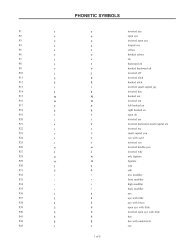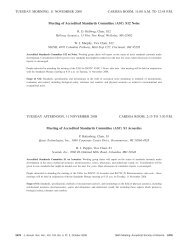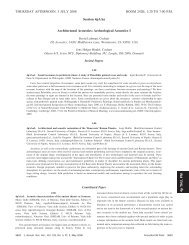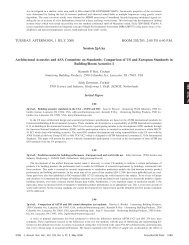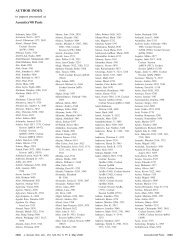Information for Contributors to JASA Express Letters - The Acoustical ...
Information for Contributors to JASA Express Letters - The Acoustical ...
Information for Contributors to JASA Express Letters - The Acoustical ...
Create successful ePaper yourself
Turn your PDF publications into a flip-book with our unique Google optimized e-Paper software.
elow:<br />
References and links [numerical style option]<br />
1<br />
R. E. Apfel and C. K. Holland, ‘‘Gauging the likelihood of cavitation from short-pulse, low duty cycle diagnostic<br />
ultrasound,’’ Ultrasound Med. Biol. 17, 179–185 (1991).<br />
2<br />
D. A. Hutchins and G. Hayward, ‘‘Radiated fields of ultrasonic transducers,’’in<br />
Ultrasonic Measurement Methods, Vol. 19 of Physical Acoustics, edited by R. N.<br />
Thurs<strong>to</strong>n and A. D. Pierce (Academic Press, New York, 1990), pp. 1–80.<br />
3<br />
QuickTime movie viewer plugins <strong>for</strong> web browsers, Welcome <strong>to</strong> QuickTime (Apple<br />
Computer, 1997), http://quicktime.apple.com. (Last viewed 29 Jan. 1998.)<br />
References and links [bibliographic style option]<br />
Apple Computer (1997). ‘‘QuickTime movie viewer plugins <strong>for</strong> web browsers,’’ Welcome <strong>to</strong> QuickTime, http://<br />
quicktime.apple.com. (Last viewed 29 Jan. 1998.)<br />
Bacon, S. P., and Viemeister, N. F. (1994). ‘‘Intensity discrimination and increment detection at 16 kHz,’’ J. Acoust.<br />
Soc. Am. 95, 2616–2621.<br />
Smith,R.L.(1988). ‘‘Encoding of sound intensity by audi<strong>to</strong>ry neurons,’’ in Audi<strong>to</strong>ry Function: Neurobiological<br />
Basis of Hearing, edited by G. Edelmann, W. Gall, and M. Cowan (Wiley, New York).<br />
Unlike multimedia material in the text (see Section 6.4), WWW URLs in the references will not be<br />
active in the posted online publication. (Clicking on a URL given in a reference will not take the reader <strong>to</strong><br />
that URL.)<br />
Since manuscripts <strong>for</strong> <strong>JASA</strong>-EL are concise descriptions of recent research, lengthy literature<br />
reviews are inappropriate. References should be chosen carefully and limited <strong>to</strong> those with a close<br />
connection <strong>to</strong> the manuscript. A reference list longer than roughly 10 items may indicate that a manuscript<br />
is inappropriate <strong>for</strong> <strong>JASA</strong>-EL.<br />
6. Figures (including multimedia) and tables<br />
6.1 Tables<br />
Tables are numbered by Arabic numerals (Table 3, Table 4, etc.) and are collected at the end of the<br />
manuscript, following the references and preceding the figure captions, one table per page. <strong>The</strong>re should be<br />
a descriptive caption above each table in the manuscript. Use horizontal lines in tables <strong>to</strong> delimit the <strong>to</strong>p<br />
and bot<strong>to</strong>m of the table and column headings. Tables are referred <strong>to</strong> in the manuscript text as Table 1, Table<br />
2, etc.<br />
Footnotes <strong>to</strong> individual items in a table are designated by raised lower case letters (0.123 a<br />
, Martin b<br />
,<br />
etc.) <strong>The</strong> footnotes as such are given below the table and should be as brief as practicable. If the footnotes<br />
are <strong>to</strong> references already cited in the text, then they should have <strong>for</strong>ms such as— a<br />
Reference 10—or—<br />
b<br />
Fires<strong>to</strong>ne (1935)—depending on the citation style adopted in the text.<br />
Due <strong>to</strong> the concise nature of <strong>JASA</strong>-EL manuscripts, they should generally have two tables or less.<br />
Submissions with more than three tables must receive permission from the Edi<strong>to</strong>r.<br />
6.2 Figures<br />
Each figure should be in a separate electronic file. <strong>The</strong> allowable <strong>for</strong>mats are TIFF, PS, EPS, or PDF <strong>for</strong>mat;<br />
one file <strong>for</strong> each cited figure number. Pho<strong>to</strong>graphs must be converted <strong>to</strong> electronic <strong>for</strong>m and presented as<br />
separate files. <strong>The</strong> inclusion of figures interspaced with the text of the submitted manuscripts leads <strong>to</strong> an<br />
undesirable risk of confusion when the manuscript is typeset <strong>for</strong> publication. For the review process, the<br />
PXP system will au<strong>to</strong>matically convert each figure <strong>to</strong> PDF and append these in numerical order <strong>to</strong> a<br />
converted PDF file of the text of the manuscript. Captions should be collected and typed on one or more<br />
double-spaced pages which follow the text of the manuscript. In the caption list, the figures should be<br />
numbered consecutively (i.e., not by section) with Arabic numbers. <strong>The</strong> detail in any figure should be<br />
commensurate with the space it will occupy in the published paper.<br />
Due <strong>to</strong> the concise nature of <strong>JASA</strong>-EL manuscripts, they should generally have three figures or less.<br />
Submissions with more than four figures must receive permission from the Edi<strong>to</strong>r. Authors are strongly<br />
encouraged <strong>to</strong> submit figures with a wide aspect ratio (ratio of horizontal <strong>to</strong> vertical dimensions), such as



